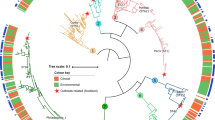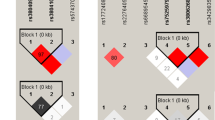Abstract
Legionella pneumophila (Lp), the etiologic agent of Legionnaires’ disease (LD), is an important cause of community-acquired and nosocomial pneumonia. However, the host immune and genetic determinants of human susceptibility to Lp are poorly understood. Here we show that both TLR6 and TLR1 cooperate with TLR2 to recognize Lp in transfected HEK293 cells. We also perform a human genetic association study of 14 candidate single-nucleotide polymorphisms in Toll-like receptors (TLRs) 1, 2 and 6 in 98 LD cases and 268 controls from the Netherlands. No polymorphisms in TLR1 or TLR2 were associated with LD. A TLR6 polymorphism, 359T>C (rs5743808), was associated with an elevated risk of LD in genotypic and dominant (odds ratio (OR) 5.83, P=7.9 × 10−5) models. The increased risk in persons with 359 TC or CC genotypes was further enhanced among smokers. In a multivariate model, 359T>C was associated with a higher risk of LD (OR 4.24, P=0.04), than any other variable, including age and smoking. Together, these data suggest that the human TLR6 variant, 359T>C, is an independent risk factor for LD.
This is a preview of subscription content, access via your institution
Access options
Subscribe to this journal
Receive 6 digital issues and online access to articles
$119.00 per year
only $19.83 per issue
Buy this article
- Purchase on Springer Link
- Instant access to full article PDF
Prices may be subject to local taxes which are calculated during checkout


Similar content being viewed by others
References
Fang GD, Fine M, Orloff J, Arisumi D, Yu VL, Kapoor W et al. New and emerging etiologies for community-acquired pneumonia with implications for therapy. A prospective multicenter study of 359 cases. Medicine (Baltimore) 1990; 69: 307–316.
Jespersen S, Søgaard OS, Schønheyder HC, Fine MJ, Østergaard L . Clinical features and predictors of mortality in admitted patients with community- and hospital-acquired legionellosis: a Danish historical cohort study. BMC Infect Dis 2010; 10: 124.
Lim WS, Macfarlane JT, Boswell TC, Harrison TG, Rose D, Leinonen M et al. Study of community acquired pneumonia aetiology (SCAPA) in adults admitted to hospital: implications for management guidelines. Thorax 2001; 56: 296–301.
Neil K, Berkelman R . Increasing incidence of legionellosis in the United States, 1990-2005: changing epidemiologic trends. Clin Infect Dis 2008; 47: 591–599.
Ruiz M, Ewig S, Marcos MA, Martinez JA, Arancibia F, Mensa J et al. Etiology of community-acquired pneumonia: impact of age, comorbidity, and severity. Am J Respir Crit Care Med 1999; 160: 397–405.
Sabria M, Yu VL . Hospital-acquired legionellosis: solutions for a preventable infection. Lancet Infect Dis 2002; 2: 368–373.
Hutchinson DN . Nosocomial legionellosis. Rev Med Micrbiol 1990; 1: 108–115.
Yu VL . Nosocomial legionellosis. Curr Opin Infect Dis 2000; 13: 385–388.
Hirschfeld M, Kirschning CJ, Schwandner R, Wesche H, Weis JH, Wooten RM et al. Cutting edge: inflammatory signaling by Borrelia burgdorferi lipoproteins is mediated by Toll-like receptor 2. J Immunol 1999; 163: 2382–2386.
Akira S, Uematsu S, Takeuchi O . Pathogen recognition and innate immunity. Cell 2006; 124: 783–801.
Girard R, Pedron T, Uematsu S, Balloy V, Chignard M, Akira S et al. Lipopolysaccharides from Legionella and Rhizobium stimulate mouse bone marrow granulocytes via Toll-like receptor 2. J Cell Sci 2003; 116 (Pt 2): 293–302.
Bulut Y, Faure E, Thomas L, Equils O, Arditi M . Cooperation of Toll-like receptor 2 and 6 for cellular activation by soluble tuberculosis factor and Borrelia burgdorferi outer surface protein A lipoprotein: role of Toll-interacting protein and IL-1 receptor signaling molecules in Toll-like receptor 2 signaling. J Immunol 2001; 167: 987–994.
Takeuchi O, Kawai T, Mühlradt PF, Morr M, Radolf JD, Zychlinsky A et al. Discrimination of bacterial lipoproteins by Toll-like receptor 6. Int Immunol 2001; 13: 933–940.
Krutzik SR, Ochoa MT, Sieling PA, Uematsu S, Ng YW, Legaspi A et al. Activation and regulation of Toll-like receptors 2 and 1 in human leprosy. Nat Med 2003; 9: 525–532.
Thoma-Uszynski S, Stenger S, Takeuchi O, Ochoa MT, Engele M, Sieling PA et al. Induction of direct antimicrobial activity through mammalian Toll-like receptors. Science 2001; 291: 1544–1547.
Akamine M, Higa F, Arakaki N, Kawakami K, Takeda K, Akira S et al. Differential roles of Toll-like receptors 2 and 4 in in vitro responses of macrophages to Legionella pneumophila. Infect Immun 2005; 73: 352–361.
Hawn TR, Smith KD, Aderem A, Skerrett SJ . Myeloid differentiation primary response gene (88)- and toll-like receptor 2-deficient mice are susceptible to infection with aerosolized Legionella pneumophila. J Infect Dis 2006; 193: 1693–1702.
Archer KA, Roy CR . MyD88-dependent responses involving toll-like receptor 2 are important for protection and clearance of Legionella pneumophila in a mouse model of Legionnaires' disease. Infect Immun 2006; 74: 3325–3333.
Fuse ET, Tateda K, Kikuchi Y, Matsumoto T, Gondaira F, Azuma A et al. Role of Toll-like receptor 2 in recognition of Legionella pneumophila in a murine pneumonia model. J Med Microbiol 2007; 56 (Pt 3): 305–312.
Misch EA, Hawn TR . Toll-like receptor polymorphisms and susceptibility to human disease. Clin Sci (Lond) 2008; 114: 347–360.
Johnson CM, Lyle EA, Omueti KO, Stepensky VA, Yegin O, Alpsoy E et al. Cutting edge: a common polymorphism impairs cell surface trafficking and functional responses of TLR1 but protects against leprosy. J Immunol 2007; 178: 7520–7524.
Thuong NTT, Hawn TR, Thwaites GE, Chau TTH, Lan NTN, Quy HT et al. A polymorphism in human TLR2 is associated with increased susceptibility to tuberculous meningitis. Genes Immun 2007; 8: 422–428.
Hawn TR, Verbon A, Janer M, Zhao LP, Beutler B, Aderem A . Toll-like receptor 4 polymorphisms are associated with resistance to Legionnaires' disease. Proc Natl Acad Sci USA 2005; 102: 2487–2489.
Hawn TR, Verbon A, Lettinga KD, Zhao LP, Li SS, Laws RJ et al. A common dominant TLR5 stop codon polymorphism abolishes flagellin signaling and is associated with susceptibility to Legionnaires' disease. J Exp Med 2003; 198: 1563–1572.
Hawn TR, Scholes D, Li SS, Wang H, Yang Y, Roberts PL et al. Toll-like receptor polymorphisms and susceptibility to urinary tract infections in adult women. PLoS One 2009; 4: e5990.
Hawn TR, Misch EA, Dunstan SJ, Thwaites GE, Lan NT, Quy HT et al. A common human TLR1 polymorphism regulates the innate immune response to lipopeptides. Eur J Immunol 2007; 37: 2280–2289.
Misch EA, Macdonald M, Ranjit C, Sapkota BR, Wells RD, Siddiqui MR et al. Human TLR1 deficiency is associated with impaired mycobacterial signaling and protection from leprosy reversal reaction. PLoS Negl Trop Dis 2008; 2: e231.
Boshuizen HC, Neppelenbroek SE, van Vliet H, Schellekens JFP, JWd Boer, Peeters MF et al. Subclinical Legionella infection in workers near the source of a large outbreak of Legionnaires disease. J Infect Dis 2001; 184: 515–518.
Chidiac C, Che D, Pires-Cronenberger S, Jarraud S, Campèse C, Bissery A et al. Factors associated with hospital mortality in community-acquired legionellosis in France. Eur Respir J 2012; 39: 963–970.
Campèse C, Bitar D, Jarraud S, Maine C, Forey Fo, Etienne J et al. Progress in the surveillance and control of Legionella infection in France, 1998-ì2008. Int J Infect Dis 2011; 15: e30–e37.
Den Boer JW, Yzerman PF, Schellekens J, Lettinga KD, Boshuizen HC, Van Steenbergen JE et al. A large outbreak of Legionnaires’ disease at a flower show, the Netherlands, 1999. Emerg Infect Dis 2002; 8: 37–43.
Jespersen S, Søgaard OS, Fine MJ, Østergaard L . The relationship between diagnostic tests and case characteristics in Legionnaires' disease. Scand J Infect Dis 2009; 41: 425–432.
Sopena N, Force L, Pedro-Botet ML, Barrufet P, Sauca G, García-Núñez M et al. Sporadic and epidemic community legionellosis: two faces of the same illness. Eur Respir J 2007; 29: 138–142.
Scharf S, Hippenstiel S, Flieger A, Suttorp N, N'Guessan PD . Induction of human beta-defensin-2 in pulmonary epithelial cells by Legionella pneumophila: involvement of TLR2 and TLR5, p38 MAPK, JNK, NF-kB, and AP-1. Am J Physiol Lung Cell Mol Physiol 2010; 298: L687–L695.
Vance R, Hawn TR . The genetics and immunology of host resistance to Legionella infection. In: Heuner K, Swanson M, (eds) Legionella: Molecular Microbiology. Caister Academic Press: Ann Arbor, MI, USA, 2008.
Braedel-Ruoff S, Faigle M, Hilf N, Neumeister B, Schild H . Legionella pneumophila mediated activation of dendritic cells involves CD14 and TLR2. J Endotoxin Res 2005; 11: 89–96.
Shim HK, Kim JY, Kim MJ, Sim HS, Park DW, Sohn JW . Legionella lipoprotein activates toll-like receptor 2 and induces cytokine production and expression of costimulatory molecules in peritoneal macrophages. Exp Mol Med 2009; 41: 687–694.
Ma X, Liu Y, Gowen BB, Graviss EA, Clark AG, Musser JM . Full-exon resequencing reveals toll-like receptor variants contribute to human susceptibility to tuberculosis disease. PLoS One 2007; 2: e1318.
Kesh S, Mensah NY, Peterlongo P, Jaffe D, Hsu K, Van Den Brink M et al. TLR1 and TLR6 polymorphisms are associated with susceptibility to invasive aspergillosis after allogeneic stem cell transplantation. Ann N Y Acad Sci 2005; 1062: 95–103.
Shey MS, Randhawa AK, Bowmaker M, Smith E, Scriba TJ, de Kock M et al. Single nucleotide polymorphisms in toll-like receptor 6 are associated with altered lipopeptide- and mycobacteria-induced interleukin-6 secretion. Genes Immun 2010; 11: 561–572.
Ozinsky A, Underhill DM, Fontenot JD, Hajjar AM, Smith KD, Wilson CB et al. The repertoire for pattern recognition of pathogens by the innate immune system is defined by cooperation between Toll-like receptors. Proc Natl Acad Sci USA 2000; 97: 13766–13771.
Sanjuan MA, Dillon CP, Tait SWG, Moshiach S, Dorsey F, Connell S et al. Toll-like receptor signalling in macrophages links the autophagy pathway to phagocytosis. Nature 2007; 450: 1253–1257.
Hajjar AM, O'Mahony DS, Ozinsky A, Underhill DM, Aderem A, Klebanoff SJ et al. Cutting edge: functional interactions between toll-like receptor (TLR) 2 and TLR1 or TLR6 in response to phenol-soluble modulin. J Immunol 2001; 166: 15–19.
West TE, Ernst RK, Jansson-Hutson MJ, Skerrett SJ . Activation of Toll-like receptors by Burkholderia pseudomallei. BMC Immunol 2008; 9: 46.
Lettinga KD, Verbon A, Weverling GJ, Schellekens JF, Den Boer JW, Yzerman EP et al. Legionnaires' disease at a Dutch flower show: prognostic factors and impact of therapy. Emerg Infect Dis 2002; 8: 1448–1454.
Storm N, Darnhofer-Patel B, van den Boom D, Rodi CP . MALDI-TOF mass spectrometry-based SNP genotyping. Methods Mol Biol 2003; 212: 241–262.
Shephard N . GENASS: Stata Module to Perform Genetic Case-Control Association Tests. Boston College Department of Economics: Chestnut Hill, MA, USA, 2005.
Acknowledgements
We thank Kamilla D Lettinga for establishing the database for patients and HC Boshuizen for establishing the database for controls. We thank Drs Alan Aderem of Seattle BioMed and Marta Janer formerly of Institute for Systems Biology for advice and genotyping assistance and Sarah Li, Rick Wells and Malinka Jansson-Hutson for technical assistance.
Author information
Authors and Affiliations
Corresponding author
Ethics declarations
Competing interests
The authors declare no conflict of interest.
Rights and permissions
About this article
Cite this article
Misch, E., Verbon, A., Prins, J. et al. A TLR6 polymorphism is associated with increased risk of Legionnaires’ disease. Genes Immun 14, 420–426 (2013). https://doi.org/10.1038/gene.2013.34
Received:
Revised:
Accepted:
Published:
Issue Date:
DOI: https://doi.org/10.1038/gene.2013.34
Keywords
This article is cited by
-
Bedeutung der Genetik für die Pneumonie und COVID-19
Der Pneumologe (2021)
-
Testosterone persistently dysregulates hepatic expression of Tlr6 and Tlr8 induced by Plasmodium chabaudi malaria
Parasitology Research (2014)



